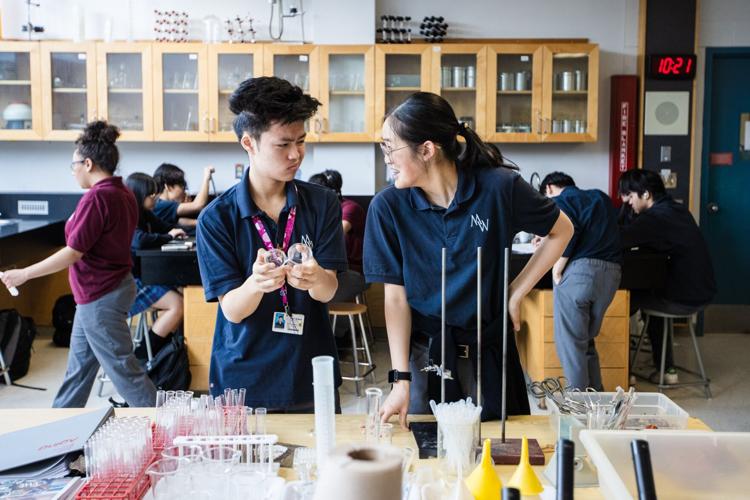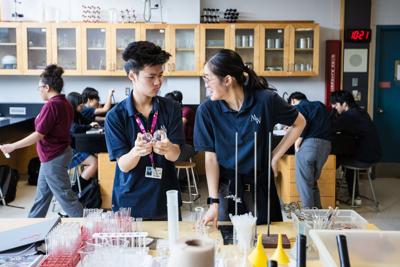░š┤Ū░∙┤Ū▓į│┘┤ŪŌĆÖs is a regular local high school, with teens goofing around, huddled in groups working on assignments and buried in books preparing for upcoming tests.
But itŌĆÖs far from typical. There are no traditional classrooms, timetables or due dates. Students pick when to be evaluated. And no bells ring to signal the change of periods.╠²Students can sit where they want for extended lengths of time.
Here, students control the pace of learning╠²ŌĆö not teachers. They decide what they want to work on each day, set their own deadlines and can create their own assignments, all while still meeting provincial curriculum requirements.
Mary Ward, on Kennedy Road near Finch Avenue East in Scarborough, is the only regular school in Toronto╠²ŌĆö and among about half a dozen across Canada╠²ŌĆö that is fully .╠²│¦┤Ū│Š▒╠²alternative programs and teachers in traditional settings have adopted elements of this approach, but few other regular schools have wholly embraced it.

Michael Wetzel is the principal at Mary Ward Catholic Secondary School in Scarborough.
Nick LachancePrincipal Michael Wetzel says the instinct amongst educators is to default to traditional schooling, with teachers controlling the flow of information.╠²But he says it doesn’t have to be that way.
ŌĆ£Education needs to be overhauled in a big way and Mary Ward already did it,ŌĆØ╠²he told the Star, which recently visited the school of about 950 students.
What does it take to succeed here?
Inside the biology lab, Anasemon Ibrahim is working with friends on an experiment about digestive enzymes. She hopes learning to juggle a heavy workload, manage her time and work independently will better prepare her for university.
She cites the “best” thing about the school is the choice of when to write a test. On the flip side, she notes that without due dates it’s easy to fall behind.
ŌĆ£If youŌĆÖre not a procrastinator and you can stay on track, then this school is for you,” she said. “But if not, itŌĆÖs going to be a bit hard.”
Notably, Mary Ward has a higher attrition rate than others╠²in the ║ŻĮŪ╔ńŪ°╣┘═°Catholic District School Board because of the program.
ŌĆ£I know a lot of really, really smart kids that go into Mary Ward ŌĆ” but they donŌĆÖt have the work ethic to back that up and then they end up transferring out,ŌĆØ says Chantle Jovellanos, also in Grade 11. ŌĆ£Mary Ward is a school where you canŌĆÖt take your foot off the gas╠²ŌĆö you need to always, always work harder to improve yourself.ŌĆØ

Chantle Jovellanos is student council vice-president at Mary Ward. She says self-discipline in crucial to succeed at the school.
Nick LachanceShe says self-discipline is crucial, especially because she can sit next to her friends all day╠²ŌĆö╠²there’s no╠²need to wait for lunch or spare to meet up╠²ŌĆö and╠²pass╠²the time chatting and laughing.
ŌĆ£You have to make that choice to separate yourself ... (to) just completely zone out, put on your headphones, and just work.”
How does a self-directed school function?
It╠²takes time to understand how the school functions╠²ŌĆö several teachers say when they started it took them months to wrap their heads around it.
All incoming students are assigned a teacher advisor (TA), a mentor of sorts who monitors their progress throughout high school.
Every TA advises about 18 students and meets with the group several times daily, beginning first thing in the morning to review how kids plan to spend their day. TAs are in regular contact with students’ teachers and every couple of weeks, they meet individually with kids to discuss how they’re doing. After that meeting, a report is sent to parents containing marks, progress and information about upcoming tests. (Once kids grasp a concept and are ready to╠²be assessed, the teacher issues a test certificate. Students choose when to go to the test centre, a large room run by instructional assistants who know which test to administer based on the certificate. Final exams, however, are written on set dates.)╠²╠²╠²
Courses are divided into 18 units with target dates. If teens donŌĆÖt finish the work by June, they can attend a summer school run by Mary Ward.
The TAs ŌĆ£make you feel like you can do it,ŌĆØ says Jissica Maher in Grade 11, adding, ŌĆ£ItŌĆÖs not just school, you can talk to the TA about anything.ŌĆØ
After checking in with the TA, students move about the day as they want, choosing where to go for each period and what to work on. For instance, Maher can spend a full day studying just math if she needs, adding, ŌĆ£It really makes me feel responsible for what IŌĆÖm doing.ŌĆØ
Students follow a set schedule during the first couple of weeks of school so they get to know their teachers, and a few days in the final months, which is when they typically go into high gear to finish course work. Otherwise, they’re on their own.
The school was purpose-built,╠²so there arenŌĆÖt traditional classrooms. Instead, large departmental areas for specific subjects are supervised by teachers, who are on hand to support students if they have questions. Teachers also give scheduled seminars, which more closely resemble a traditional class in that they provide direct instruction.
Wetzel has heard the jokes that Mary Ward is the school where teachers don’t teach, but he says that’s not the case. They’re busy all day, having to constantly pivot and help kids of various grades, working through different material.╠²
Many students relish the flexibility, including elite athletes, who can leave school early, arrive late or miss chunks of time for training or competitions. Among them is Alexa Fung, a diver on the Canadian junior national team who goes to school once a month.
ŌĆ£I thought it was super cool that you could just do your own thing,ŌĆØ says the Grade 11 student. “I still have a schedule, itŌĆÖs just that I make it up.ŌĆØ

Mary Ward students Alexa Fung, left, a diver on the Canadian junior national team,╠²and Nydel Nelson, who plays for Guyana’s Under 20 national soccer team.╠²
Nick LachanceShe likes learning at her own pace, saying if she were in a traditional classroom sheŌĆÖd likely get bored, particularly if she had to sit through a lesson when she already understood the material. She prefers to plough ahead.
ŌĆ£In elementary school I wasnŌĆÖt as outgoing but now that I came to Mary Ward, I’ve forced myself to communicate with adults and ask for help when needed,ŌĆØ╠²adds╠²Nydel Nelson, whoŌĆÖs on GuyanaŌĆÖs Under 20 womenŌĆÖs national soccer team and also travels for competitions.
Does self-directed learning work?
ItŌĆÖs difficult to assess the impact of this learning model, but the TCDSB is planning to do some research, connecting with past and present students.
The school has a reputation for high academic achievement, with students outperforming on standardized tests administered by the Education Quality and Accountability Office. For instance, the show Mary Ward students scored about 10 percentage points higher in attaining the provincial standard╠²ŌĆö roughly a B grade or better╠²ŌĆö on the Grade 9 math test, and high school literacy test, compared with averages from across the board and province.
Wetzel also says there are ŌĆ£almost zeroŌĆØ discipline issues at Mary Ward. Since students of all grades intermingle all day long thereŌĆÖs no distinction, or hierarchical structure, so there’s less intimidation and bullying, when compared with a typical school. And being free to move about, not confined to a classroom, also helps, he says, pointing out that elsewhere teens are bound to act up if theyŌĆÖre forced to sit in a class and listen to a teacher when they donŌĆÖt want to. (Here students can take a stroll when they want and some routinely do╠²ŌĆö kids call them “hall walkers.”)

Mary Ward science teacher Christina Burns, left, talks with students Anasemon Ibrahim, Esther Matta and Jissica Maher as they prepare for an experiment that will mimic the human digestive system.╠²
Nick LachanceIn general, self-directed learning is great for highly motivated students with good time management skills and who are eager to delve into areas of interest, says Todd Cunningham, an associate professor at the Ontario Institute for Studies in Education at the University of Toronto.
ŌĆ£It really allows them to explore a lot more and probably get a lot more learning in the year than if they were sitting in a traditional classroom,ŌĆØ said Cunningham, also a clinical and school psychologist.
John Portelli, professor emeritus from OISE, welcomes more alternative approaches to learning.
ŌĆ£There is a bias towards these schools╠²ŌĆö they are there in the minimum. And I think they should be made more available,ŌĆØ he says. ŌĆ£I do not believe in one size fits all╠²ŌĆö and the problem with traditional public schooling is that it believes in one size fits all.ŌĆØ╠²╠²
In the United States, various private and public schools have adopted this approach over the last 20 years, says Naomi Boyer, chair of the .╠²
In a skills-based economy, she says, “folks who cannot self-direct their learning, and have ownership over their learning process, are likely not to be as successful in the work world moving forward.”
Mary Ward started in 1985 as a series of portables and the founding principal, Mary Anne OŌĆÖLeary, introduced self-directed learning, which had╠²gained popularity in the U.S. and Canada in the 1960s and 1970s.╠²(Wetzel says many fizzled after bending to the pressures of unions, critics and lack of understanding about the program.)╠²
Although there was some initial skepticism, when construction started on a new school building, the staff, and board, were on side and it was purposely designed. Doors opened in 1992.
Former history teacher Marg Gardonio, now retired, recalls, ŌĆ£It was a very exciting venture╠²ŌĆö itŌĆÖs kind of taking schooling to the point of education ŌĆ” I donŌĆÖt think we educate much in schools. We school kids.ŌĆØ
ŌĆ£Our model says (to students) ŌĆśYou’re in charge. You’re the architect of your learning. Go and make some decisions,ŌĆÖ”╠²says John Notten, another former teacher from Mary Ward, also retired.╠²”ŌĆ” Teenagers can make very bad decisions. So thatŌĆÖs risky ŌĆ” Now, when they make good decisions, the benefits are insurmountable.ŌĆØ





































To join the conversation set a first and last name in your user profile.
Sign in or register for free to join the Conversation